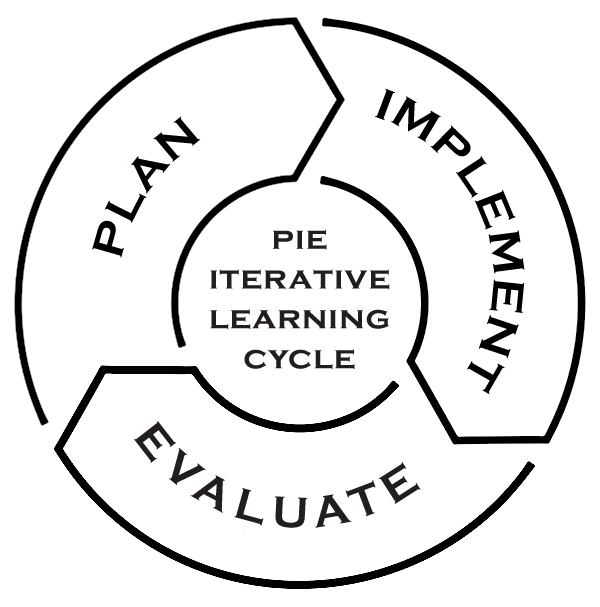

Iteration is the act of repeating a process, either to generate an unbounded sequence of outcomes, or with the aim of approaching a desired goal, target or result. Each repetition of the process is also called an "iteration", and the results of one iteration are used as the starting point for the next iteration. Wikipedia
- I wanted to design a shared online document that connected learning activities together to form a unit.
- Then, connect the units to each other to form an online curriculum map.
- Specifically, I wanted to create an integrated studies unit designer that patterned a learner’s natural ability to be curious and create things.
- As a mental image, I wanted the unit designer to function much like the circular links of a Slinky, an iterative circle connected- moving forward to the next circle, or looking back to the previous one.
Stepped Models of Teaching
From a constructivist view, knowledge is directly experienced through a process often linked or looped from one experience to the next in an ongoing endeavor toward understanding. However, as the industrialization of the United States progressed during the 20th century with a growing population attending public education, an emphasis on teaching techniques that provided structure with classroom management superseded the more natural and cyclical 'learning by doing' approach.
The development of direct instruction within a single subject time period bolstered the role of the front and center teacher using a lesson structure from state adopted textbooks. From the 1960’s and into this century, many stepped models of instruction were developed to deliver content with defined starting and stopping points. This is exemplified through the work of Dr. Madeline Hunter (1916-1994) with her eight element lesson design that has been adopted or adapted by countless educators.
- Anticipatory Set
- Objective and Purpose
- Input
- Modeling
- Checking for Understanding
- Guided Practice
- Independent Practice
- Closure
These instructional steps reflect a process for the transference of knowledge over the construction of knowledge. The transmission of knowledge is usually delivered through direct talk and possible modeling from the teacher. This is commonly followed by a dialogue between teacher and students and then followed by a review and possible revision of the work. Not that any of these steps are bad or irrelevant today as instructional strategies, it's just designed from a teacher-centered perspective, the person who is typically controlling the action from the front of the room. Stepped models of teaching are:
- focused on students’ behaviors, what is seen by the teacher;
- keeping teachers themselves on task to cue, model and guide students;
- promoting order and more
certain learning outcomes compared to messy uncertainties within a learning
environment; and,
- straightforward in terms of evaluating skills of students by teachers, and in turn, teachers by administrators.
Stepped models of instruction foster a learning environment where sitting and listening are greatly valued by adults. However for children and young people, this type of teaching is often disconnected from learning in environments outside of school. This didactic teaching creates a prevailing state of passivity that kills students’ curiosity and creativity, not to mention their excitement, motivation and relevance of learning about our world.
From Sage... to Facilitator for Understanding
For the past twenty-five years, we’ve all heard the expression, “from sage on the stage to guide on the side” (A. King 1993), but haven’t seen a lot of evidence of that transformation in K-12 classrooms. The role of the teacher is in fact slowly changing in America. The world of work in the United States influences the world of school. The 21st century workplace from the office to shop floor now share similarities compared to our industrial age past within business, organizations and industry. Work environments have given way from top-down styles of management to a more flexible team dynamic where managers and staff must work in collaborative teams to plan, problem-solve, create or produce things, together.
As boss kings and individual work cubicles continue to fade and morph into flexible work teams and environments, the role of the teacher and the classroom itself are also evolving. The 21st century version of teacher from sage to guide may be more something like- from lord of the interactive whiteboard to classroom conductor.
K-12 teachers have long been expected to be charismatic, knowledgeable in multiple subjects or experts in single subjects with the instructional ability to present content. All teachers have felt the immense pressure to 'stand and deliver' that rivals a professional stand up comedians gig. While the role of teacher as the front and center leader is still the norm in our current education system, here I advocate reducing this role (not to mention stress) from skilled practitioner of content and explicit instruction to a 'facilitator for understanding.'
As a sign of our times herein lies a current paradox- K-12 educators embrace design thinking for students within the traditional instructional context of direct instruction taught in a single subject by teachers. Is it any wonder that educators have been talking about project-based learning since the middle of the last century, but that model still is relegated to a 'special project' rather than the norm.
New teacher skill sets in this century require teachers to be flexible project coordinators, curious learners, and creative individuals. As a skilled facilitator, the focus shifts from teaching to learning and disrupts the teaching practice that direct-stepped instruction is the default way to learning in K-12 classrooms.
What if we turned that linear didactic model on its head? A place where students woke up in the morning and wanted to be. A place where messy learning outcomes with a bit more classroom chaos were actually embraced by the system, where high-stakes state testing was not the definitive measure of student success and, where unpredictably created options for students!
Facilitated Cycles of Learning
In reading the book, Invent to Learn: Making Tinkering and Engineering in the Classroom by Sylvia Libow Martinez and Gary Stager, I had an instructional epiphany. Martinez and Stager present examples such as, 'the 5 paragraph essay' and 'scientific method' to illustrate their point of “explicit teaching of facts and procedures” as the norm in school compared to “design models from the real world.” What if like in the real world of making things, iterative design cycles could transform how we approach learning design in schools.
When designing physical products, there is a time when planning must end and you commit to building something. You can tinker with a bridge design while it’s on the computer, but once you start building it in the real world, the design tinkering has to stop.
In electronics, you can place components on a “breadboard” and try out various circuits. If you make a mistake or don’t like a result, you can pull out the wires and try again. Fabrication allows you to quickly build prototypes on an inexpensive 3D printer until you are satisfied enough to commit to a finished design.
In the world of digital products, like software, apps, and websites, this design philosophy can go a step further. You can tinker even as you build, spiraling through a series of stages as you make progress. These modern, tinkering-friendly design models are known by various names including “rapid prototyping,” “spiral design,” “iterative design,” and “agile development.”
Martinez’s and Stager’s
brilliance in their wonderful book struck a chord in my thinking as they then
lay out an easy to remember three-step “iterative design cycle” called, “TMI - Think, Make, Improve.”
In the classroom, iteration through multiple design cycles is useful and relevant. Not only is it more “real world” than linear methods, it matches the inclination of children to do something quickly rather than to spend a lot of time planning.
As students go through multiple design cycles, they develop a better understanding of the requirements, tools, and materials as they make tradeoffs and try to improve their prototype. These cyclical phases allow the teacher to see progress and make sure that students are moving forward towards a goal, not procrastinating until the last minute.
By thinking we plan, by making we create, and by improving we can
reflect to make it better, which brings us back around to thinking in the next
iteration of the project. Not only that, it creates a real-life context for
teaching that naturally puts the teacher in the real life role of facilitator
for understanding. These three easy to remember Think-Make-Improve action words represent a broader subset of verbs
and got my brain storming with ideas.
Easy as PIE
In quickly going back to the opening goal statement in this chapter, I wanted to create a simple integrated studies learning cycle model that patterned a learner’s natural ability to be curious and create things.
In building off Martinez’s and Stager’s TMI iterative design cycle for making something, I also wanted to create an iterative process that could be used in an easy to remember three-phase model for a variety of learning activities. These activities are student-centered that have more of a natural flow of process over explicit steps of teacher-centered instruction. I call this process an “iterative learning cycle.”
In following the Martinez/Stager playbook, I then came up with a catchy acronym to remember, PIE (Plan - Implement - Evaluate).
If a teacher or team of teachers were creating a unit of study, within that unit they could develop a number of multiple learning cycles or PIEs. Within each PIE iteration would include the essential learning activity or middle “I” for students to Implement – to put a plan into action and then evaluate their implementation.
In creating a constructivist pedagogy, I wanted the PIE process to include (but not limited to), two essential learning activities-
- To Inquire by researching big ideas, questions and concepts; or,
- To Invent something of any kind- from writing a poem about plants, planting a garden, or designing a farmers market.
Like the TMI model, I wanted the PIEs model to be easy to remember and work somewhat like muscle memory in that the learner-centered instructional process moves forward but underneath, acting without conscious effort, not overtly directing the inquiry or invention.
K-12 instruction is commonly built upon the foundation that a group of lessons are presented in sequence to represent a 'unit of study.' Here, lessons are a group of coordinated 'learning activities' that make a PIE iteration. The next iteration is a new PIE and on-and-on towards the students’ understanding of a big idea.
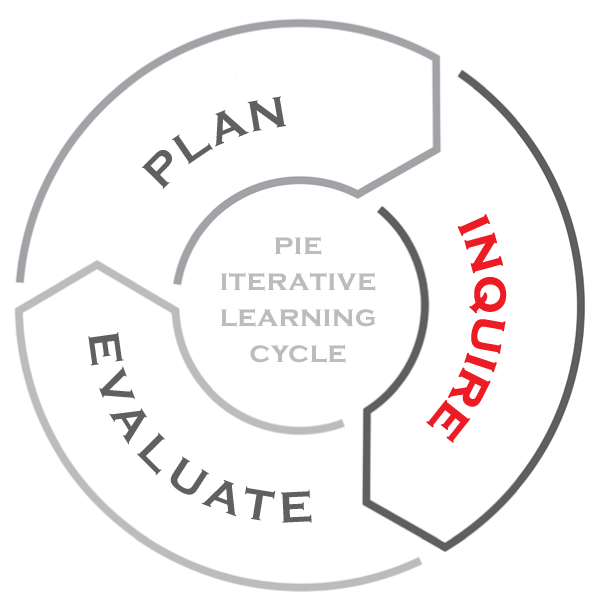
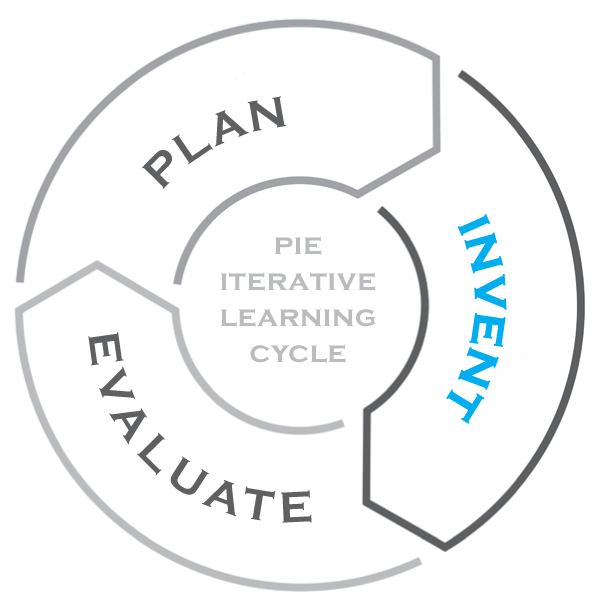
As teachers design a coordinated learning unit using any number of PIE iterative learning cycles, I call this, “baking PIEs.” The beauty of this learning design is the teacher’s role as facilitator- to easily modify a PIE or bake a new PIE based on the students’ experiences of the previous PIE cycle. The process of baking PIEs optimizes the teacher’s role as a facilitator. It creates a learner-centered structure that allows for the teacher to pull back or jump in, as necessary- a monitor and mentor.
Note - As I continue to write and edit this ehandbook in HTML, it in itself is an iterative learning process much like a Wiki. My writing not only represents an archive of my thinking, but is the ongoing slinky that evolves from one learning loop to the next.
PIE Iterative Learning Cycle with Subset Verbs
To describe the plethora of activities involved in iterative learning cycles, I started a PIE color-coded action word list as a resource to be used with the, PIE Iterative Learning Cycles - Unit Designer-
Plan
Activate prior knowledge
Brainstorm
Chart
Discuss
Design
Diagram
Draft
Envision
Formulate
Goal
Idea
Identify
Intend
Layout
Map
Method
Organize
Outline
Overview
Personalize
Plant
Plot
Prepare
Procedure
Project
Purpose
Proposal
Question
Scenario
Sketch
Strategy
System
Target
Teaming/Group work
Think
Tools/Technology needed
Implement
Inquire
Access
Analyze
Ask
Compare/Contrast
Deconstruct
Think Deeper
Discover
Examine
Experiment
Explore
Find
Gather
Inspect
Interview
Investigate
Look into
Observe
Organize/Pattern
Probe
Problem-solve
Question
Read
Realize
Research
Search
Seek
Scout
Scrutinize
Sift
Sort
Study
Take apart
Invent
Actualize
Ad-lib
Build
Code
Cook
Coin
Compose
Conceive
Construct
Choreograph
Create
Develop
Devise
Draw/Paint
Fabricate
Fashion
Form
Initiate
Innovate
Make
Manufacture
Movement
Perform
Play
Produce
Program
Sew
Tinker
Think up/Dream up
Write
Evaluate
Adjust
Analyze
Assess
Appraise
Calculate
Check out
Classify
Critique
Cycle again
Cycle new
Decide
Deem
Estimate
Examine
Grade
Gauge
Improve
Feedback
Fix
Judge
Make it Better
Outcome
Perform
Present
Rank
Rate
Repair
Reflect
Review
Share
Survey
Test
Value
Viewpoint
Weigh
From Integrated Studies Units to School Curriculum Map
In the following sections, I present an iterative unit designer where integrated studies units are directly linked to a school’s online curriculum map. The unit designer and curriculum map provide a school’s administration and teachers a foundation for professional learning that models an iterative process. A site-based curriculum map transforms traditional textbook 'scope and sequence' teaching into a flexible learners’ curriculum. The online curriculum map is also the school’s central marketing tool. As part of a 21st century modern learning perspective, it is very important that the pedagogical learning process is transparently presented to parents and the local learning community. When ready for the public, the curriculum map is linked to the school’s website and shows the world that your school is a leader in K-12 education.
PIE Iterative Learning Cycles Unit Designer
The following (FIGURE 3.1-3.4) is a Google Doc template- PIE Iterative Learning Cycles Unit Designer.
Teachers with the link below can-
- Open the File Menu and Make a copy...
- Rename the file name to create their own editable version, share and give editing privileges to
collaborating teachers.
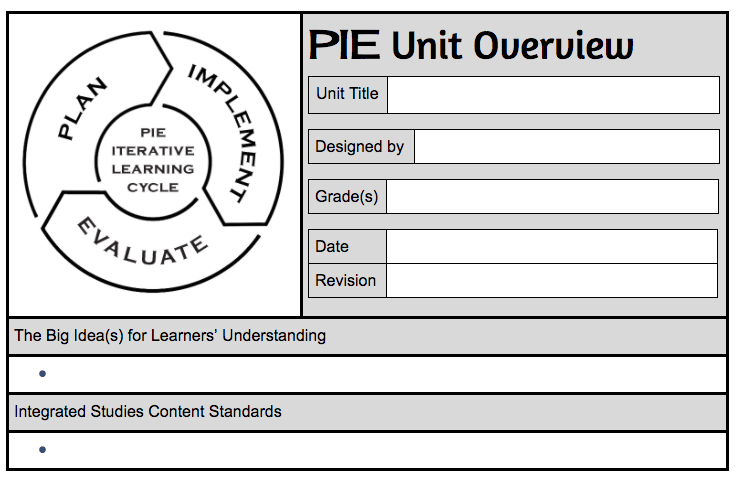
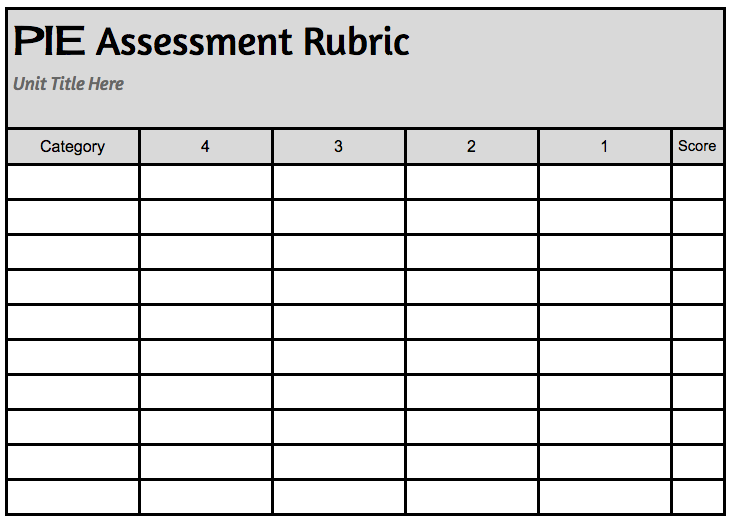
FIGURE 3.3 – Page 3, PIE Iterative Learning Cycle - Unit Planner
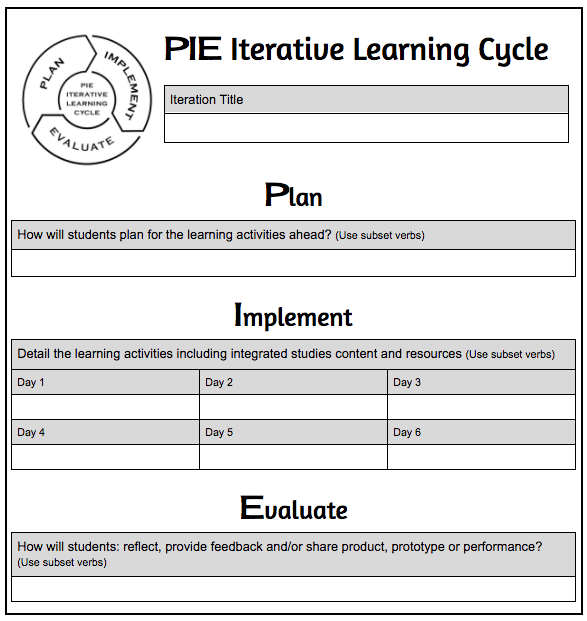
Integrated Studies School Curriculum Map
The Integrated Studies School Curriculum Map is a living ongoing and online collaborative document. Working in typically grade level PLC’s, integrated studies units are created by teachers and when ready, are linked in the school curriculum map. Teacher teams always have access to their units as editors, and public access is always as “viewer only” to these documents.
The following (FIGURE 3.4) Google Doc is the Integrated Studies Curriculum Map Template. A school administrator or person assigned to manage the school curriculum map with the link below- can open the file and “Copy to” and create their own editable version of the map. I recommend that the manager of curriculum map only share with one or two other key people as this is central “read only” document that will eventually be shared with the world.
FIGURE 3.4 - Integrated Studies Curriculum Map Template
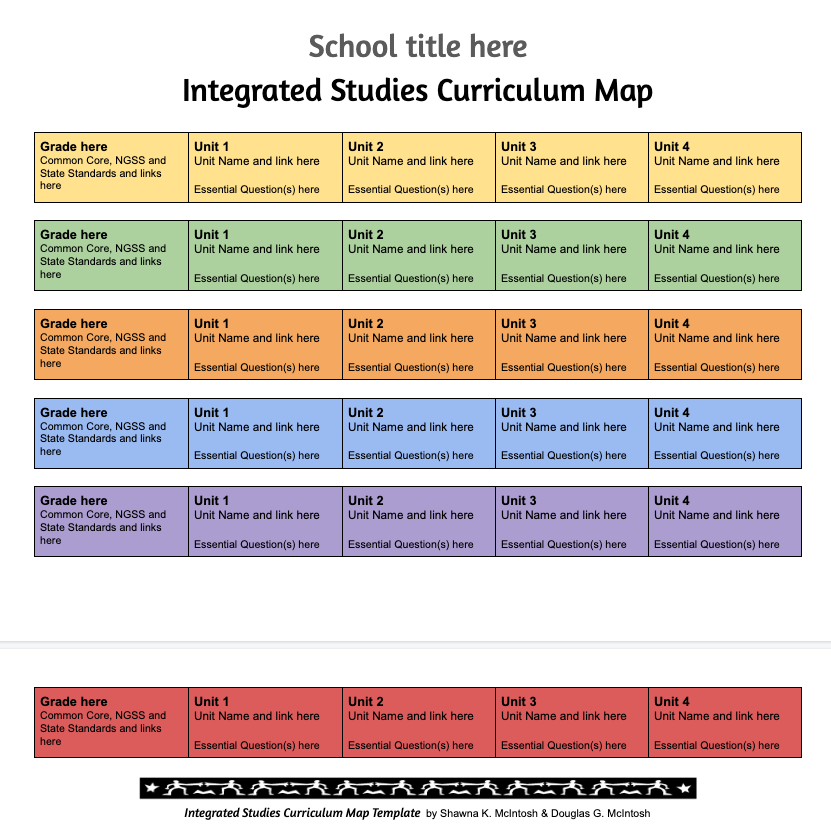
Here are a few guiding points for unit development and appropriating teachers’ valuable time.
- 'Teacher training hour is dead'. Instead, let’s give teachers the gift of time with 'professional learning' with a laser focus and long-range purpose to transform instruction in their classrooms.
- Integrated studies unit development gives teachers a motivating purpose to create a tangible product for their classrooms, libraries or labs. If you want to create a maker culture at your school, the teachers should be modeling making by making units of study that integrate making in learning activities.
- Units of study developed at the school level will never happen without mandatory teacher 'PLC Unit Time.' If you can schedule weekly, by bimonthly or at the least, monthly PLC unit development, you will be ahead of the 6+ year sustainability thing.
- As a new unit of integrated study is developed by an individual or team, continue to improve on that unit every year.
- In the iterations of your unit, build up to where minimally the core four subjects are integrated as a series of connected learning activities.
- Learning activities supersede isolated content lessons because they are driven by a big idea through essential questions to guide the activities within a unit.
- Learning activities put the students’ learning first where engagement is increased because of their direct participation in an inquiry about the big idea and/or a project where the students make something as a learning outcome.
Big6.com. (2017). Big6 Skills
Overview - Big6. Retrieved from
http://big6.com/pages/about/big6-skills-overview.php
Dam, R., & Siang, T. (2017). 5 Stages in the Design Thinking Process. Interaction Design Foundation. Retrieved from https://www.interaction-design.org/literature/article/5-stages-in-the-design-thinking-process
Edutopia. (2017). Inquiry-Based Learning. Retrieved from https://www.edutopia.org/topic/inquiry-based-learning
Edutopia. (2017). Project-Based Learning. Retrieved from https://www.edutopia.org/project-based-learning
Google.com. (2017). Google Docs - Create and edit documents online, for free. Retrieved from https://www.google.com/docs/about/
International Baccalaureate®. (2017). Retrieved from: http://www.ibo.org/
Jacobs, H.H. (1997). Mapping The Big Picture. Alexandria: Va.: Association for Supervision and Curriculum Development
Larmer, John. (2017). Project-Based Learning vs. Problem-Based Learning vs. X-BL | Edutopia. Retrieved from https://www.edutopia.org/blog/pbl-vs-pbl-vs-xbl-john-larmer
Martinez, S. L., & Stager, G. (2013) Invent To Learn: Making, Tinkering, and Engineering in the Classroom. Torrance: CA: Constructing Modern Knowledge Press
Mathfilefoldergames.com. (2017) Madeline Hunter's 8-Step Lesson Plan Format | Math File Folder Games. Retrieved from http://www.mathfilefoldergames.com/madeline-hunters-8-step-lesson-plan-format
McIntosh, D. (2018) Google.com. PIE Unit Designer Template - Google Docs. Retrieved from https://docs.google.com/document/d/1i9XYYLGqCPfer5pTQpEZryGmFNX80Ry5bxXJt6gn0Ng/edit
McIntosh, S. (2017) Google.com. Washington Elementary STEAM Magnet Curriculum Map - Google Docs. Retrieved from https://docs.google.com/document/d/1oTjvQLEdh6ObCaiwuDMIUQvSpzlnCIJhkedgveBE5vw/edit
McKenzie, Jamie. (2000) Beyond Technology. Bellingham: Wash.: FNO Press
Richard, C. (2017) Iterative Design. Retrieved from http://www.instructionaldesign.org/models/iterative_design.html
San Diego Unified School District | Clairemont High School. (2017). Engineering Design. Retrieved from https://www.sandiegounified.org/schools/clairemont/engineering-design
San Diego Unified School District | Washington Elementary STEAM Magnet School. (2017). Home. Retrieved from https://www.sandiegounified.org/schools/washington
Stateuniversity.com. (2017). Madeline Cheek Hunter (1916–1994) - Teacher, Teaching, Student, and Students - StateUniversity.com . Retrieved from http://education.stateuniversity.com/pages/2074/Hunter-Madeline-Cheek-1916-1994.html
Washington Elementary STEAM Magnet Curriculum. (2017). Home. Retrieved from http://www.washingtonsteam.com/
Wikipedia.org. (2017). Iteration - Wikipedia. Retrieved from https://en.wikipedia.org/wiki/Iteration
Wikipedia.org. (2017). Muscle memory - Wikipedia. Retrieved from https://en.wikipedia.org/wiki/Muscle_memory
Wiggins, G. and McTighe, J. (2005). Understanding by Design Alexandria: VA: Association for Supervision and Curriculum Development

No part of this publication may be reproduced, distributed or transmitted in any form or by any means, including photocopying, recording, or other electronic or mechanical methods, without the prior written permission of the publisher, except in the case of brief quotations embodied in critical reviews and certain other noncommercial uses permitted by copyright law. For permission requests, write to the publisher, addressed “Attention: Permissions Coordinator,”
at the address below.
Groupwerk Publishing
Skinner Building
1326 Fifth Avenue | Suite 438
Seattle, WA 98101
